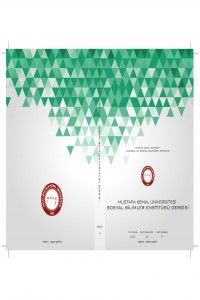Akıllı Tahtalar Ve Öğretim Uygulamaları/Smart Boards And Their Instructional Uses
Eğitim Teknolojisi, Akıllı Tahta, Etkileşimli Beyaz Tahta, Etkileşimli Öğrenme Ortamı
___
- Kaynakça
- Bacon, S. M., & Finnemann, M. D. (1990). “A study of attitudes, motives and strategies of university foreign language students and their disposition to authentic oral and written input”. Modern Language Journal, 74(4), 459–473.
- Beauchamp, G. (2004). “Teacher use of the interactive whiteboard in primary schools: Towards an effective transition framework. Technology”, Pedagogy and Education 13(3), 327-348.
- Beauchamp, G., & Parkinson, J. (2005). “Beyond the 'wow' factor: developing interactivity with the interactive whiteboard”. School Science Review, 86(316), 97-103.
- Collins, B. C., Gast, D. L., Wolery, M., Holcombe, A., & Leatherby, J. G. (1991). “Using constant time delay to teach self-feeding to young students with severe/profound handicaps: Evidence of limited effectiveness”. Journal of Developmental and Physical Disabilities, 3, 157-178.
- Feasy, R. (2004). “Thinking and working scientifically”, (pp. 44-87). In Skamp, K. (Ed.), Teaching primary science constructively (l2nd ed.). Southbank Victoria: Thomson.
- Gerard, F., & Widener, J. (1999). “A SMARTer way to teach foreign language: The SMART board interactive whiteboard as a language learning tool”. Retrieved August 23, 2010, from http://edcompass.smarttech.com/en/learning/research/SBforeignlanguageclass.pdf
- Gürel, G., Ülgen, E., Çağıltay, K., Yıldırım, S. (2007). “Problems and expectations of instructors in terms of technology use in higher education: A descriptive study”. Proceedings of the 32nd IUT (Improving University Teaching) Conference. Jaen, Spain.
- Hall, J., Chamblee, G., & Hughes, T. (2008). “Teacher perceptions of interactive whiteboards: A comparison of users and future-users in high school and middle school mathematics”. In K. McFerrin et al. (Eds.), Proceedings of Society for Information Technology and Teacher Education International Conference 2008 (pp. 4461- 4467). Chesapeake, VA: AACE.
- Harlan, J. D., & Rivkin, M. S. (2000). Science experiences for the early childhood years:An integrated approach. Upper Saddle River, NJ: Pearson Education Inc.
- Judge, S. L. (2001). “Computer applications in programs for young children with disabilities: Current status and future directions.” Journal of Special Education Technology, 16, 29-30.
- Kennewell, S., & Morgan, A. (2003). S”tudent teachers' experiences and attitudes towards using interactive whiteboards in the teaching and learning of young children”. In J. Wright, A. McDougall, J. Murnane, & J. Lowe (Eds.), Young children and learning technologies (pp. 71-76). Sydney: Australian Computer Society.
- Kent, P. (2004). “Smartboards: Interactive whiteboards in classrooms”. Retrieved August 9, 2010 from http://www.eastchester.k12.ny.us/schools/hs/teachers/blaser/documents/SMART
- BoardsInteractiveWhiteBoardsintheClassroom.pdf
- Lee, M., & Boyle, M. (2003). The educational effects and implications of the interactive whiteboard strategy of Richardson Primary School: A brief review. Retrieved August 23, 2010, from http://richardsonps.act.edu.au/RichardsonReview_Grey.pdf
- Mechling, L. C., Gast, D. L., & Krupa, K. (2007). “Impact of SMART board technology: An investigation of sight word reading and observational learning”. Journal of Autism and Developmental Disorders, 37, 1869-1882.
- Minor, B., Bracken, M., Geisel, P., & Unger, S. (2006). SMART boards in the classroom: The Influence of interactive boards in education. Retrieved August 16, 2010, from http://tiger.towson.edu/users/sunger2/smart_boards_in_the_classroom.htm
- Moffatt, K. (2000). EGEMS – Electronic games for education in Math and Science: Evaluating the use of a SMART board to teach transformation geometry using Super Tangrams.
- Okolo, C. M., Bahr, C. M., & Rieth, H. J. (1993). “A retrospective review of computer-based instruction”. Journal of Special Education Technology, 12, 1-27.
- Pennington, M. C (1996). The power of CALL. Houston, TX: Athelstan Publications.
- Preston, C., & Mowbray, L. (2008). “Use of SMART boards for teaching, learning and assessment in kindergarten science”. Teaching Science, 54(2), 50-53.
- Salinitri, G., Smith, K., & Clovis, C. (2002). The aural enabler: Creating a way for special needs kids to participate in the classroom lesson. Retrieved August 17, 2010, from http://downloads.smarttech.com/media/sitecore/en/pdf/research_library/special_ed/the_aural_enabler.pdf
- Saltan, F. (2010). “Teachers' acceptance of interactive white boards: A case study”. In D. Gibson & B. Dodge (Eds.), Proceedings of Society for Information Technology & Teacher Education International Conference 2010 (pp. 2360-2365). Chesapeake, VA: AACE.
- Smith, H. J., Higgins, S., Wall, K., & Miller, J. (2005) “Interactive whiteboards: Boon or bandwagon? A critical review of the literature”. Journal of Computer Assisted Learning, 21(2), 91–101.
- Smith, L. (2008). “An investigation into the effect of a NATE/Becta training programme on the use of interactive whiteboards in teaching and learning in Secondary English”. English in Education, 42(3), 269-282.
- Starkings, S., & Krause, L. (2008). “Chalkboard to smartboard – maths going green?” MSOR Connections, 7(4), 13-15.
- Başlangıç: 2004
- Yayıncı: Hatay Mustafa Kemal Üniversitesi
Güney HACIÖMEROĞLU, Çavuş ŞAHİN
Mehmet İLBAN, Mehmet AKKILIÇ, Özer YILMAZ
Esin ŞAHİN, Sedat MADEN, Mehmet KARDAŞ, Abdullah ŞAHİN
BİR KÜLTÜREL LİDERLİK PARADOKSU: PATERNALİZM
Akıllı Tahtalar Ve Öğretim Uygulamaları/Smart Boards And Their Instructional Uses
Tufan ADİGÜZEL, Neşe GÜRBULAK, Hakan SARİÇAYİR
SINIF ÖĞRETMENİ ADAYLARININ BİLİMİN DOĞASI KAVRAMLARI: TEORİ, YASA VE HİPOTEZ
